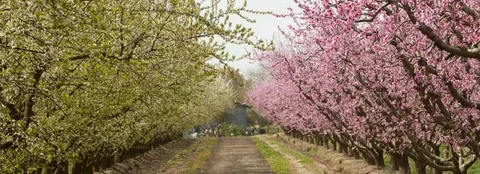As winter loosens its grip and the air begins to soften, a quiet spectacle unfolds across Portugal’s inland countryside. Long before the beaches crowd and the coastal cities awaken from their off-season slumber, a delicate transformation begins among the terraced hills and river valleys of the interior: the almond trees bloom. Their pale pink and white petals, like confetti tossed by an unseen hand, signal not just the change of season, but the quiet rebirth of places overlooked by the usual traveler’s gaze.
The Portugal holidays so many know for golden sands and sun-soaked cities miss this secret inland show entirely. Here, in places like the Douro Valley and the Alentejo interior, entire villages celebrate the almond blossom’s brief reign. It’s a time of local fairs, slow walks, and traditional pastries made from the very nuts the trees will later bear. This is the Portugal of poets, farmers, and storytellers—a Portugal rooted in the land.
And while the coastlines pull most travellers toward bustling resorts, those craving a more soulful experience are beginning to follow the flowering paths inland. Some holidays to Portugal, especially during late winter and early spring, now cater to those seeking immersion in local traditions and landscapes. Even Madeira Portugal holidays, though set on an island, sometimes mirror this seasonal beauty with their bursts of floral glory. Travelodeal, among others, has quietly included spring blossom trails and countryside stays for travellers ready to experience Portugal beyond the obvious.
Where the Blossoms Bloom First
The journey along the Almond Blossom Trail begins in the country’s northeast, where the rugged terrain of Trás-os-Montes hides villages that feel untouched by time. Here, the flowering begins in late January, turning the brown hills into soft watercolour canvases. Mirandela, Mogadouro, and Vila Nova de Foz Côa are among the places where entire hillsides are painted with blossoms, and locals celebrate with food fairs and cultural events tied to the arrival of spring.
Further south, the trail meanders through the Côa Valley—an area also known for its prehistoric rock art and stark, untamed beauty. Hikes through this region are rewarded not only by stunning views and ancient history but also by the fragrant canopy of almond trees in bloom above your head and the sound of bees humming in anticipation of a new season.
Driving or cycling through these regions during the flowering weeks is to witness an ephemeral form of magic. It’s a reminder of how quickly nature moves—and how much beauty lies in things that don’t last.
Almonds, Ancients, and Artisan Touches
Spring’s arrival also marks the return of time-honoured traditions. Locals harvest almond blossoms to flavour sweets, press oils, and create artisanal products sold only at this time of year. Bakeries bring out their best seasonal specialities, like almond-filled pastries and marzipan treats shaped like the flowers themselves. Small family-run cafés in these hidden regions become hubs of activity, where travellers and locals trade tips on the best trails, views, and blossom-timing.
In towns like Torre de Moncorvo, local festivals dedicate entire weekends to celebrating the almond trees—with live folk music, traditional dress, and market stalls offering crafts and foods tied to the season. It’s here that spring in Portugal feels most authentic—not orchestrated for tourism, but unfolding naturally, with open doors and warm welcomes.
The Road Less Traveled is Often the Most Rewarding
Following the almond blossoms is not about flashy attractions or jam-packed itineraries. It’s about slowing down and letting nature lead. It’s about stopping the car because a field of petals caught the light just right or hiking a path simply because an old man in a café said it was his favourite. These are not sights you’ll find on postcards, but memories that linger far longer.
Portugal’s inland spring is soft-spoken, but it speaks to the traveller who listens. Those who follow the blossoms will find not just beauty, but a deeper connection to the rhythm of the land—and perhaps a new way of travelling entirely.

